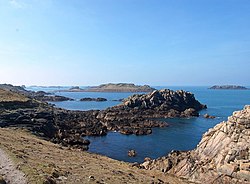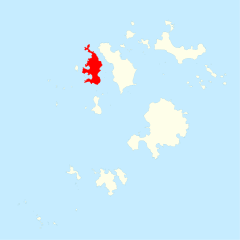Bryher: Difference between revisions
m moved Bryher, Isles of Scilly to Bryher |
mNo edit summary |
||
| Line 5: | Line 5: | ||
|picture=Hell Bay, Bryher - geograph.org.uk - 401278.jpg | |picture=Hell Bay, Bryher - geograph.org.uk - 401278.jpg | ||
|picture caption=Hell Bay, Bryher | |picture caption=Hell Bay, Bryher | ||
|map=Bryher | |map=Bryher island Scilly.svg | ||
|os grid ref=SV876361 | |os grid ref=SV876361 | ||
|population=83 | |population=83 | ||
Latest revision as of 15:54, 29 February 2012
| Bryher | |
 Hell Bay, Bryher | |
|---|---|
| Location | |
| Grid reference: | SV876361 |
| Data | |
| Population: | 83 |
Bryher is the smallest of the five inhabited islands of the Isles of Scilly, part of Cornwall; less than a mile and a half long and a half a mile or so broad. Bryher lies to the west of Tresco, and is separated from that island by the Tresco Channel, once the main anchorage for the islands and now an area where sandflats are exposed at low tide.
Off the southern end of Bryher is the uninhabited island of Samson. It is possible to walk between the three islands at the lowest spring tides.
The centre of Bryher is mainly low lying with arable fields, pasture and housing and is where most of the population of 83 lives. On the west side is the brackish Great Pool overlooked by the Hell Bay Hotel and in the south are sandy beaches, a common feature on the island, Rushy Bay being an example. The island lies within the Isles of Scilly Heritage Coast, is part of the Isles of Scilly Area of Outstanding Natural Beauty and untennanted land is leased by the Duchy of Cornwall to the Isles of Scilly Wildlife Trust which is using ponies and red ruby cattle[1] to graze the overgrown areas as part of the Waves of Heath project.
There is one church on the island: All Saints.
Local activities include boating, walking and watching wildlife.
Hell Bay
The infamous Hell Bay can be found on Bryher. This Atlantic-facing cove became a notorious place for shipwrecks over the 18th and 19th century though there is little evidence to support this, most ships had been wrecked before they even reached here.
Bar Quay
In the centre of the island is Bar Quay, which was built in 1990 by volunteers for the television programme Challenge Anneka. It is known to many islanders as 'Anna-Quay'. In 2007 it was replaced by a new concrete quay, as part of a Scilly-wide programme of quay rebuilding.
Natural History
There are three Sites of Special Scientific Interest (SSSI) on Bryher. The "Shipman Head and Shipman Down SSSI" was first designated in 1971 and covers 99 acres of the northern part of the island. Waved maritime heath grows over shallow podzolic soils which are underlain by Hercynian granite. Rare plants include the Red Data Book (RDB) Orange Bird’s-foot (Ornithopus pinnatus) and the nationally scarce Hairy Bird’s-foot trefoil (Lotus subbiflorus). Lichens include (Lobaria pulmonaria) and (Teleoschistes flavicans).[2]
On the west side of the island is Great Pool which is part of the "Pool of Bryher and Popplestone Bank SSSI". It is separated from the sea by a storm beach and small dune system, and is the only natural brackish lagoon on Scilly with plants such as Saltmarsh Rush (Juncus gerardii) and Beaked Tasselweed (Ruppia maritima).[3]
Covering 30 acres of the southern part of the island is the "Rushy Bay and Heathy Hill SSSI" which has a number of nationally rare plants. An Isles of Scilly speciality is the Dwarf Pansy (Viola kitaibeliana) which grows nowhere else in Great Britain. It is locally abundant on Bryher and thousands can be found in May in short turf and bare sand. Unfortunately a storm in 2008 reduced the numbers of plants seen; there are also small colonies on Tresco and Teän. Orange Bird’s-foot, Small Adder’s-tongue (Ophioglossum azoricum) and Autumn’s Lady’s-tresses (Spiranthes spiralis) grow on Heathy Hill.[4]
Breeding Birds
Shipman Head has seven species of breeding seabirds:
- Kittiwake (Rissa tridactyla)
- Herring Gull (Larus argentatus)
- Greater Black-backed Gull (Larus marinus)
- Lesser Black-backed Gull (Larus fuscus)
- Razorbill (Alca torda)
- Shag (Phalacrocorax aristotelis)
- European Storm Petrel (Hydrobates pelagicus)
Ringed Plover (Charadrius hiaticula) breed on Shipman Down.[2]
Visiting the island
Varied accommodation is available on the island. The Hell Bay Hotel is located close to the coast on the west side. There are guesthouses, self-catering cottages and a campsite. Two quays are used (depending on tides) by boats which take tourists between Bryher and other islands, including St Mary's and Tresco. On some low tides it is possible to walk between Bryher and Tresco and even Samson, the uninhabited island to the south. There is also safe anchorage for small yachts in the channel and Green Bay.
In the north of the island are the Fraggle Rock Bar, Vine Cafe and the new Bryher shop.
The Golden Eagle Gig shed on the west coast is the studio of the artist Richard Pearce.
Use in film and television
- The Voyage of the Dawn Treader BBC television adaptation in 1989 used Bryher for some of the scenes.
- When the Whales Came was made on location in 1989
In fiction
Bryher features in various books:
- Michael Morpurgo:
- The Wreck of the Zanzibar
- The Sleeping Sword
- Why the Whales Came
- Hell Bay by Sam Llewellyn
Outside links
References
- ↑ Western Morning News article
- ↑ 2.0 2.1 "Shipman Head and Shipman Down". Natural England. http://www.sssi.naturalengland.org.uk/citation/citation_photo/1002021.pdf. Retrieved 8 December 2011.
- ↑ "Pool of Bryher and Popplestone Bank". Natural England. http://www.sssi.naturalengland.org.uk/citation/citation_photo/1001961.pdf. Retrieved 8 December 2011.
- ↑ "Rushy Bay and Heathy Hill". Natural England. http://www.sssi.naturalengland.org.uk/citation/citation_photo/1001981.pdf. Retrieved 8 December 2011.
| Isles of Scilly |
|---|
|
St Mary's •
St Agnes •
Tresco •
Bryher •
St Martin's •
Gugh
|
